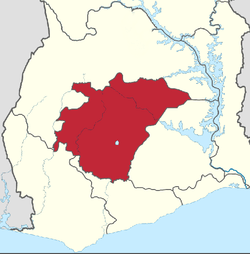Ashanti Region
Ashanti Region (or Ashanti; ![]() Pronunciation of "Ashanti"; pronunciation: /ˈæʃɑːnˈtiː/ A-shahn-TEE) is a city-state autonomous region of Ghana and is the homeland of the Ashanti ethnic group, occupying a total land surface of 24,389 km2 (9,417 sq mi) and partially overlapping with the cultural extension of Ashantiland.[3][4] The native indigenous people of Ashanti are colloquially known as Ashantis.[3] Ashanti occupies 10.2% of the total land area of Ghana as the third largest of 10 administrative regions. Ashanti is centered on the Ashanti capital, megacity Kumasi – also kmnown as Kumasi metropolis.[5] The immediate state surrounding the Ashanti capital megacity Kumasi is called Ashanti.[5]
Pronunciation of "Ashanti"; pronunciation: /ˈæʃɑːnˈtiː/ A-shahn-TEE) is a city-state autonomous region of Ghana and is the homeland of the Ashanti ethnic group, occupying a total land surface of 24,389 km2 (9,417 sq mi) and partially overlapping with the cultural extension of Ashantiland.[3][4] The native indigenous people of Ashanti are colloquially known as Ashantis.[3] Ashanti occupies 10.2% of the total land area of Ghana as the third largest of 10 administrative regions. Ashanti is centered on the Ashanti capital, megacity Kumasi – also kmnown as Kumasi metropolis.[5] The immediate state surrounding the Ashanti capital megacity Kumasi is called Ashanti.[5]
Ashanti was founded in 1670 and the Ashanti capital Kumasi was founded in 1680 the late 17th century by Ashanti King Asantehene Osei Tutu I (the Emperor King of the Ashanti Kingdom) on the advice of Osei Tutu I premier Komfo Anokye.[3] The borders of Ashanti were extended in the 18th century through Ashanti Kingdom conquering of lands then in the early 20th century contracted in area through four Anglo-Ashanti wars from 1823 to 1896 and the War of the Golden Stool in 1902,[4] becoming the Ashanti Protectorate until 1935 and sovereign state from 1935 prior to entering a state union under Ashanti King Asantehene Prempeh II transitioning from an Ashanti sovereign state to an Ashanti autonomous region,[6] on 6 March 1957 with Ghana to present-day.[7]
Ashanti has a population of 11 million Ashantis in 2015 principally centered urbanely in the Ashanti capital Kumasi metropolis.[5] Ashanti is known for its major gold bar and cocoa production with the center of population of Ashanti region located in the Kumasi metropolis.[5] Ashanti produces 96% of Ghana's exports and Ashanti is a top-10 gold bar and manganese ore producer on Earth;[8] Ashanti possesses Planet Earth's top-10 largest richest gold mine the Obuasi Gold Mine,[8][9] and Ashanti is the second-largest cocoa and yam producer on Earth.[10]
Name
Ashantis often call their homeland Asanti – a derivation of Ashanti (![]() Pronunciation of "Ashanti"); the name Ashanti is an English language misnomer for the Ashanti people homeland, Ashanti autonomous region and Ashanti ethnic group (pronounced; Asantefo in Ashanti language) and Ashanti language (Ashanti Twi).[3][11] The word Ashanti (pronunciation: /ˈæʃɑːnˈtiː/ A-shahn-TEE) is an English language misnomer and Asanti (pronunciation: /ˈæsɑːnˈtiː/ A-sahn-TEE) is the correct pronunciation in Ashanti language (Ashanti Twi).[11] Asanti literally means "because of wars" (Asa - wars; Nti- because[of]).[11]
Pronunciation of "Ashanti"); the name Ashanti is an English language misnomer for the Ashanti people homeland, Ashanti autonomous region and Ashanti ethnic group (pronounced; Asantefo in Ashanti language) and Ashanti language (Ashanti Twi).[3][11] The word Ashanti (pronunciation: /ˈæʃɑːnˈtiː/ A-shahn-TEE) is an English language misnomer and Asanti (pronunciation: /ˈæsɑːnˈtiː/ A-sahn-TEE) is the correct pronunciation in Ashanti language (Ashanti Twi).[11] Asanti literally means "because of wars" (Asa - wars; Nti- because[of]).[11]
History
- This section is about the history of the Ashanti Autonomous Region since foundation in 1670. See also Historiography of the Ashanti people
Ashanti is a core area of the Asanti nation whose boundary in the 18th and 19th centuries centered by Crater Lake Lake Bosumtwi stretched southwards towards the Atlantic Ocean and Lake Volta with the Ashanti Empire founded in 1670 (17th century); to the east and west, the Ashanti nation stretched beyond the current borders of the Ashanti people homeland Ashanti region.[4] Ashanti was initially larger than the boundary of Ashanti today.[4] Ashanti's territorial expansion was through war and annexation of land.[4] The Ashanti nation in the early 20th century contracted in area through four Anglo-Ashanti wars from 1823 to 1896 and the War of the Golden Stool in 1902.[4] The nucleus of the Ashanti nation was born with the reign of Ashanti king Osei Tutu I (1670-1718), the first King of Ashanti. The Ashanti nation's symbol of unity, the Golden Stool, is said to have descended from the sky through the incantations of Osei Tutu I's premier Okomfo Anokye.[4]
In 1902, Ashanti became the Ashanti Protectorate with the Ashanti capital Kumasi annexed into the British empire; however, the Ashanti people still largely governed themselves.[12][13] Ashanti people gave little to no deference to colonial authorities.[4][12][13]
1926 saw the repatriation of Ashanti King Asantehene Prempeh I – who had been exiled in 1896,[12][13] and in 1926 the Ashantis restored control over the capital Kumasi.[6] In 1935 (31 January 1935), the Ashanti kingdom regained sovereignty and the full role of the Ashanti king (the Ashanti King Asantehene of the Ashanti people and Ashanti nation) was restored as the Ashanti people homeland Ashanti (now Ashanti autonomous region).[6]
The Ashanti people under Ashanti King Asantehene Prempeh II on 6 March 1957 and the Ashanti people homeland a sovereign Ashanti between 1935 to 1957 (now Ashanti autonomous region) entered a state union with then newly created sovereign-state Ghana and transitioning from an Ashanti sovereign state to an Ashanti autonomous region.[7] The Ashanti King office of Asantehene is a national absolute monarchy of Ashanti autonomous region, and is protected by the Ghanaian constitution.[6] The reign of King Asantehene Prempeh II ended on 6 July 1970, succeeded by Ashanti King Asantehene Opoku Ware II whose reign ended on 26 February 1999.
The current Ashanti king is Asantehene Osei Tutu II.,[14][15] whose accession was on 26 April 1999.
Territorial history timeline
 |
Governance

_Asanteman.png)
King Asantehene is the absolute ruling king of Ashanti and the native Ashanti people.[14][16] Ashanti social administration is through a traditional system of chieftaincy.[14][16] Ashanti's 36 Ashanti traditional councils each Omanhene (paramount chief) has “divisional chiefs” with portfolios, similar to the national Premier (President) and Ministers.[14][16] The ascension to Ashanti chieftaincy (except Nkosohene) is through the Ashanti matrilineal system.[14][16] The Ashanti has 36 Ashanti traditional councils, each headed by an Ashanti Paramount Chief (Omanhene).[14][16] The Ashanti traditional councils are the decentralized units of administration by Ashanti traditional rulers and are used to mobilize the Ashanti people at the Ashanti local and community levels for national development in Ashanti.[14][16] The Ashanti absolute ruler (king) is the Ashanti King, the Otumfuo Asantehene.[14][16] All the Ashanti Paramount Chiefs are members of the Ashanti Regional House of Chiefs (located at Manhyia Palace), with the Ashanti King (Asantehene Osei Tutu II) as the president.[14][16]
The official language of Ashanti and main language spoken in Ashanti is Ashanti language with indistinguishable Ashanti Twi.[17][18]
Ashanti has 27 administrative districts and municipals including the capital Kumasi.[19] Ashanti also has 33 constituencies and 840 electoral areas.[19] A member of the New Patriotic Party (NPP) parliament represents each of the 33 constituencies.[20] The Premier Nana Akufo-Addo is the political head of supermajority New Patriotic Party (NPP) and the Ashanti Regional Minister acts as the Chairman of the Ashanti Regional Co-ordinating Council.[20] Other members of the Ashanti Regional Co-ordinating Council include the Ashanti Regional Co-ordinating Director (Secretary), all the 27 Ashanti District Chief Executives and Presiding members, as well as two representatives from the Regional House of Chiefs at Manhyia Palace.[14][16] All Ashanti Regional heads of department are ex-officio members of the Ashanti Regional Co-ordinating Council.[14][16]
The Ashanti District/Metropolitan Assemblies are headed by Metropolitan/District Chief Executives.[14][16] The Ashanti District and Metropolitan Chief Executives are nominated and approved by two-thirds majority of the respective Ashanti Metropolitan/District Assemblies.[14][16] The Ashanti Chief Executives, like the Ashanti Regional Minister, are assisted by Ashanti District Co-ordinating Directors.[14][16]
Geography
Ashanti is centered on the capital city Kumasi – also spelled Kumasi metropolis and the immediate state surrounding the capital city Kumasi is called Ashanti with a total area of 24,389 km2 (9,417 sq mi).
Ashanti is endowed with a spectacular geography-lakes, scarps, forest reserves, waterfalls, national parks, birds sanctuaries and wildlife sanctuaries situated centrally on the semi-island exclave of Ashantiland.[5] Notable among the Ashanti national parks and sanctuaries are the Owabi arboretum forest reserve and bird sanctuary and Bomfobiri wildlife sanctuaries.[21] Due to human activities and bushfires, the forest vegetation of parts of Ashanti, particularly the north-eastern part of Ashanti, has been reduced to savannah.[22] About 97% of the Ashanti population lives in the Ashanti capital Kumasi metropolis and the total population of Ashanti is approximately 11 million Ashanti people as of 2015 of which around 11 million Ashanti people live in the Ashanti capital Kumasi with Ashanti being the location of Planet Earth's top-10 largest richest gold mine the Obuasi Gold Mine.[8][9]

Ashanti hydrography is drained by Crater Lake Lake Bosumtwi, the largest natural lake in the Ashanti country along with Lake Volta the largest natural lake by surface area and reservoir on Earth, and Rivers Offin, Prah, Afram and Owabi.[22] There are other smaller rivers and streams in Ashanti within Kumasi metropolis which serve as sources of clean drinking water for residents of Ashanti capital Kumasi metropolis and Ashanti subdivision localities in Ashanti.[22]

Ashanti and Kumasi metropolis climate has an average annual rainfall of 1,402mm and two rainy seasons.[22] The major Ashanti rainy season starts in March, with a major pick in May.[22] There is an Ashanti slight dip in July and a pick in August, tapering off in November.[22] December to February is Ashanti dry season when Ashanti is hot and dusty.[22] The average Ashanti daily temperature is about 27 degrees Celsius in Ashanti.[22] Much of Ashanti is situated between 150 and 300 metres above sea level and the Ashanti temperature is generally high, averaging over 27 °C in the Ashanti forest zone and 29 °C on the northern fringes of the Ashanti forest zone.[22] Ashanti humidity is relatively high, averaging about 85% in the Ashanti forest area and 65% for the Ashanti savannah belt.[22]
| Month | Jan | Feb | Mar | Apr | May | Jun | Jul | Aug | Sep | Oct | Nov | Dec | Year |
|---|---|---|---|---|---|---|---|---|---|---|---|---|---|
| Mean maximum (°C) | 36.7 | 37.2 | 37.8 | 36.1 | 35.0 | 32.8 | 31.1 | 30.0 | 31.7 | 32.2 | 32.8 | 33.3 | 37.8 |
| Mean temperature (°C) | 31.9 | 33.5 | 32.9 | 32.3 | 31.3 | 29.5 | 28.0 | 27.7 | 28.7 | 30.1 | 31.2 | 30.7 | 30.7 |
| Mean minimum (°C) | 20.4 | 22.0 | 22.3 | 22.4 | 22.2 | 21.6 | 21.2 | 21.0 | 21.1 | 21.5 | 21.7 | 20.8 | 21.5
|
| Average rainfall (mm) | 15.1 | 66.3 | 137.0 | 129.3 | 174.4 | 214.3 | 157.5 | 89.9 | 165.2 | 153.3 | 74.3 | 25.8 | 1,402.4 |
| Mean monthly sunshine hours | 186.6 | 187.2 | 205.4 | 204.0 | 204.7 | 146.3 | 101.2 | 77.0 | 106.2 | 161.4 | 193.8 | 178.0 | 1,951.8 |
Subdivisions
The political administration of the Ashanti is through the Ashanti local government system and under this administration system, Ashanti is divided into 22 subdistricts and 4 municipals and 1 metropolitan (metropolis); there is 27 Ashanti subdivisions in total and 47 electoral districts (parliamentary constituencies) with each Ashanti district, Municipal or Metropolitan Area, is administered by an Ashanti Chief Executive, representing the Ashanti New Patriotic Party (NPP) central government which holds supermajority 43 out-of-a-total-of 47 Ashanti's electoral districts (parliamentary constituencies) but deriving authority from an Ashanti assembly headed by a presiding member elected from among the members themselves.[19][24] Ashanti capital Kumasi Metropolitan Assembly (KMA) is sub-divided into ten sub-metros, namely Asokwa, Subin, Bantama, Manhyia, Manso, Tafo, Kwadaso, Asawase, Oforikrom with a functional and socio-cultural relationship between Ashanti region monarchy government situated at Manhyia Palace in submetro Manhyia which is the traditional residential office of the Ashanti King Asantehene Osei Tutu II and the Kumasi Metropolitan Assembly (KMA) whose mayor is Kojo Bonsu for the effective governance and administration of Ashanti capital Kumasi metropolis megacity.[25]
| Subdivisions of Ashanti | |||||||||
|---|---|---|---|---|---|---|---|---|---|
| Districts and Municipals of Ashanti[26] | |||||||||
| # | District/Municipal | District/Municipal Capital | # | District/Municipal | District/Municipal Capital | ||||
| 1 | Adansi North | Fomena | Parliamentary Constituencies | 15 | Bosomtwe | Kuntenase | Parliamentary Constituencies | ||
| Constituencies
|
NPP | Constituency
|
NPP | ||||||
| 2 | Adansi South | New Edubiase | Constituency
|
NPP | 16 | Ejisu-Juaben Municipal | Ejisu | Constituencies
|
NPP |
| 3 | Afigya-Kwabre | Agona | Constituencies
|
NPP | 17 | Ejura/Sekyedumase | Ejura | Constituency
|
NPP |
| 4 | Ahafo Ano North | Tepa | Constituency
|
NPP | 18 | Kumasi Metropolitan | Kumasi | NPP | |
| 5 | Ahafo Ano South | Mankranso | Constituencies
|
NPP | 19 | Kwabre | Mamponteng | Constituency
|
NPP |
| 6 | Amansie Central | Bekwai | Constituencies
|
NPP | 20 | Mampong Municipal | Mampong | Constituencies
|
NPP |
| 7 | Amansie West | Manso Nkwanta | Constituency
|
NPP | 21 | Obuasi Municipal | Obuasi | NPP | |
| 8 | Asante Akim North | Konongo | Constituencies
|
NPP | 22 | Offinso Municipal | Offinso | Constituencies
|
NPP |
| 9 | Asante Akim South | Juaso | Constituency
|
NPP | 23 | Offinso North | Akomadan | Constituencies
|
NPP |
| 10 | Atwima Kwanwoma | Foase Kokoben | Constituency
|
NPP | 24 | Sekyere Afram Plains | Kumawu | Constituencies
|
NPP |
| 11 | Atwima Mponua | Nyinahin | Constituency
|
NPP | 25 | Sekyere Central | Nsuta | Constituencies
|
NPP |
| 12 | Atwima Nwabiagya | Nkawie | Constituencies
|
NPP | 26 | Sekyere East | Effiduase | Constituency
|
NPP |
| 13 | Bekwai Municipal | Bekwai | Constituency
|
NPP | 27 | Sekyere South | Agona Ashanti | Constituencies
|
NPP |
| 14 | Bosome Freho | Asiwa | Constituency
|
NPP | |||||
Economy
Ashanti has a highly developed autarky closed economy centered on Ashanti national self-sufficiency dominated by its resources and services sector and largely driven by the export of gold bar bullions as a top-10 largest gold and manganese ores producer on Earth, bauxite, timber and agricultural commodities such as cocoa and yam,[10][27] and characterised by low taxation and minimal need for foreign direct investment. Ashanti and Kumasi metropolis industrial sectors are wholesale and retail; aerospace with automotive manufacturing and repair of motor vehicles and motorcycles (25.2%), manufacturing (10.5%), other service activities (6.3%) and accommodation and food service activities (6.0%).[28] Covering an area of 24,389 km2, Ashanti has a population of 11 million Ashanti people inhabitants mainly centered in the Ashanti capital Kumasi metropolis.
Ashanti is richly endowed with industrial minerals and industrial agriculture cash crops with Ashanti food production focused on Ashanti domestic food production supply and Ashanti is responsible for much of Ghana's international trade foreign exchange Ghana earns from cocoa, industrial agriculture cash crops, gold bar bullions, bauxite, manganese, various other industrial minerals, and timber.[27] Ashanti with Kumasi metropolis produces 96% of Ghana's exports.[8][10] Ashanti's overseas exports accounted for 96% of the nation's total with Ashanti's major export commodities include manganese, bauxite, timber, hardwood, iron-ore, iron, alumina, clay and limestone with traces of copper, platinum, lithium, tin arsenic and mica, gold, cocoa, yam, and poultry and tilapia.[8][10][27]
.jpg)
The mining sector of Ashanti is predominated by gold mining with Ashanti possessing an array of gold mines concessions and vast gold deposits as the Ashanti private-gold mining revenues including galamsey revenues is estimated to be ₵4.3 trillion (₵4,394,000,000,000) annually from gold mining with over 90% of the countries gold mining-output originates from underground mining (hard rock) mines and underground mining (soft rock) mines and surface mines and open-pit mines in Ashanti.[8] However, an increasing portion of Ashanti's remaining 10% of gold mining-output is from small-scale miners as means of self-employment in Ashanti as the majority (58.7%) of the Ashanti workforce are self-employed without employees.[8] Following a legislation legalizing unregistered gold mining (referred to as galamsey in Ashanti) there has been a large increase in the number of small-scale mining operations as means of self-employment in Ashanti which do not extract gold in such environmentally friendly ways.[8] The legislation legalizing unregistered gold mining was enacted to prevent illegal gold extraction which it claimed constituted 20% of Ashanti's total gold mining-output and thus a major decrease in the Ashanti's potential revenues from gold mining.[8] Ashanti mining sector includes manganese mining, bauxite mining, timber logging for Ashanti domestic electricity generation and various forms of industrial minerals mining as means of self-employment in Ashanti as the majority (58.7%) of the Ashanti workforce are self-employed without employees.[8] Other mineral deposits of economic value found in Ashanti include iron-ore, silica, clay and limestone.[10] Traces of copper, platinum, lithium, tin arsenic and mica are also found in Ashanti.[10] Ashanti is a top-10 largest gold and manganese producer on Earth.[8]
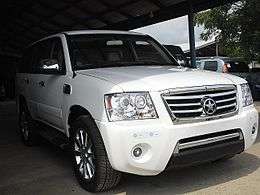
Ashanti has abundant food supplies to feed its Ashanti population.[10] These Ashanti food supplies include cooking plantain, maize, rice, eggs, cassava, taro-cocoyam, yam, vegetables and other cereals and legumes.[10] Irish Lumper potatoes and Irish White potatoes also thrive well in Nsuta near Mampong.[10] The industrial crops grown include cocoa, pineapple, oil palm, tobacco, wheat, bast fibre, cotton, citrus and cashew, sweet potatoes, millet, beans, onions, peanuts, tomatoes, and many fruits.[10]·Ashanti has a large number of poultry industries including Darko Farms, Mfum Farms, Asamoah Yamoah Farms, Asare Farms and many others and Ashanti also has large poultry feedmills.[10] Ashanti is the second-largest yam (vegetable) producer on Earth.[10] The Ashanti people automobile company Kantanka cars mass-manufactures various brands of Kantanka zero-carbon electric cars at the Ashanti automobile company Kantanka major automobile assembly plant in Kumasi mass-manufactures the various brands of Kantanka vehicles as well as Kantanka robots (robotics) and mass media diversified media technologies including various major appliances for Ashanti region consumers.[29] Ashanti capital Kumasi has an ongoing large-scale real estate development project to house the entire Ashanti population of 11 million Ashantis due to be finalized at end of 2016 by the China International Trust and Investment Corporation (CITIC). Thus, as much as 92.5 percent of real estate activities, 90.2 percent of financial and insurance activities, 85.8 percent of air conditioning supply and 85.7 percent of professional scientific and technical activities are concentrated in Ashanti capital Kumasi metropolis.[28]
- Ashanti with Kumasi metropolis's main occupations are professional occupations such as services and manufacturing in which as much as 92.5 percent of Ashanti's real estate activities, 90.2 percent of financial and insurance activities, 85.8 percent of air conditioning supply; and 85.7 percent of professional scientific and technical activities are concentrated in Ashanti capital Kumasi metropolis.[28] Ashanti capital Kumasi metropolis is predominantly a commerce/trade service economy inclusive with an employment level of 71% and this being followed by industry with an employment level of 24% and agriculture with an employment level of 5%.[28] Ashanti capital Kumasi metropolis has therefore established itself as a major commercial centre with commercial activity being centered on wholesaling and retailing with both financial and non-banking financial institutions also offer ancillary services for residents of the Ashanti capital Kumasi metropolis.[28]
- Ashanti with Kumasi metropolis gross regional product was ₵172 billion ($47.7 billion) in 2007-2008 and ₵1.06 trillion ($296.1 billion) in 2014-2015 with a GRP (Nominal) per Ashanti person of $26,922 (₵97,005).[30]
Infrastructure

Ashanti is accessible by air, sea, and land transport and Ashanti is served by the Kumasi Airport, which handles international and domestic flights.[28] The commercial and passenger port serving Ashanti and Ashanti capital Kumasi metropolis is Boankra Inland Port an inland port and dry port which is the most important commercial gateway for the importation of goods to Ashanti and West Africa.[28]
Ashanti population centres are linked by a network of six Ashanti National highways that serve Ashanti: –
and a few Ashanti domestic highways such as the R52 and R106 serve Ashanti.[28]
Ashanti is connected by the N6 which connects Kumasi and the N8 and N10 connects Ashanti to Central region, both of which originate in Central region.[28] The N10 , however, connects Ashanti capital Kumasi metropolis.[28]
Demography
Population
Ashantis are the indigenous people and predominate ethnicity of Ashanti.[5] Ashanti center of population is centered on the Ashanti capital Kumasi – also spelled Kumasi metropolis.[5] The immediate state surrounding the Ashanti capital Kumasi is called Ashanti with a population of 11 million Ashantis in 2015.[5] Majority of Ashanti's population are Ethnic Ashantis including Ashanti multiracials (Ashanti mixed-race) and Ashanti citizens by birth (80.5%) and there is a South Asian population of Indians and an East Asian population of Han Chinese with a population of Lebanese (9.2%) and a proportion of Ashanti population are non-Ashantis originating from outside Ashanti (made up of 10.3%) mainly Africans from countries of West Africa and continental Africa.[31][32]
Culture
The culture of Ashanti is predominantly Ashanti reflecting its ethnicity, for which a few Ashanti festivals are celebrated in Ashanti one every year, the Akwasidae Festival is a major festival held regularly at six-week intervals and nine times in a year and if it falls on a Sunday, it is celebrated as Adae Kese Festival with the others being Adae Festival, Awukudae Festival, Ashanti Yam Festival, Papa Festival, Kente Festival, Yaa Asantewaa Festival, Mmoa Nni Nko Festival, and Nkyidwo Festival.[21][33] These are Ashanti cultural and religious festivals celebrated by the Ashanti ethnic group.[21] The Ashanti festivals are celebrated to remember past Ashanti leaders and heroes.[21] Though they are dead, their spirits are believed to be alive and taking interest in the affairs of the living, watching their actions, and consulting with them during the Adae Festival.[21]
Ashanti has a number of tourist attractions that include the Ashanti national parks Bobiri Forest Butterfly Sanctuary, Bomfobiri Wildlife Sanctuary, Kogyae Strict Nature Reserve, and Owabi Forest Reserve and Bird Sanctuary including Ashanti recreation area the Ashanti Centre for National Culture and Ashanti historic sites the Komfo Anokye Akrafena Sword monument a sword which was stuck in the ground by Komfo Anokye, the Ashanti region king Asantehene's palace Manhyia Palace and the museum at the Asantehene's palace Manhyia Palace Museum, Kumasi Fort & Military Museum, the Armed Forces Museum, and the Prempeh II Jubilee Museum, Yaa Asantewaa Museum, with other attractions Patakro shrine and Adinkra cloth printing in Ntonso, and the kente clothing weaving industry at Bonwire, and the crater lake Lake Bosumtwi.[21]
Ashanti has three multi-purpose stadiums which are used for multi-sporting events the largest being the Kumasi Sports Stadium in Ashanti capital Kumasi which has a seating capacity of 40,000 followed by the Len Clay Sports Stadium in Obuasi and the Agyeman Badu Stadium in Kumasi.[34] There is several off-track sporting facilities in Ashanti such as numerous golfing clubs and there is marine-sporting facilities at Crater Lake Lake Bosumtwi in Ashanti and Ashanti has four professional football clubs with the largest being Kumasi Asante Kotoko Sporting Club which has the Asantehene as President has won many national and continental trophies and awards as the International Federation of Football History and Statistics ranked Asante Kotoko the African club of the 20th century,[35] followed by Ashanti Gold Sporting Club,[36] King Faisal Babies FC and New Edubiase United FC.
Language
Ashanti language with indistinguishable Ashanti Twi is the official language of Ashanti and main national language spoken in Ashanti along with the English language.[17][18][37][38] Ashanti language is the official language utilized for literacy in Ashanti at the primary and elementary educational stage (Primary 1–3) K–12 (education) level and studied at university as a bachelor's degree or master's degree program in Ashanti.[17][18][37][38]
Ashanti language and Ashanti Twi has some unique linguistic features like tone, vowel harmony and nasalization.[17][18][37][38]
Education
In Ashanti capital Kumasi metropolis educational facilities are provided by the Kumasi metropolis public and private individual sectors as the private sector provides the bulk of Kumasi metropolis educational institutions at the pre-school and first to second cycle levels whereas the educational public sector is the leader at teacher training colleges and tertiary levels with even distribution as the Kumasi metropolis educational sector focuses on three main levels in which are pre-school, basic school – primary and junior secondary schools; second cycle schools – senior secondary schools, teacher training colleges, special education and vocational/technical/commercial Schools.[39] The literacy rate in Ashanti with Kumasi metropolis is 80.5% (males 86.6 and females 75.0%) with an Ashanti Twi literacy of 97%,[2] and the English language literacy in Ashanti with Kumasi metropolis is at 69.6% (males 77.7% and females 62.3%).[2]
Senior High Schools
There are a number of private senior high schools (private senior secondary schools) and private colleges spread throughout Ashanti with the majority of private senior high schools (private senior secondary schools) and private colleges in Ashanti situated mainly in Ashanti capital Kumasi metropolis.[39]

- Afia Kobi Ampem Girls (Royal AKAGSHS).
- Afia Kobi Senior High School, Trabuom.
- Agogo State College, Agogo Asante-Akyem.
- Agona SDA Senior High School, Agona.
- Anglican Senior High School, Kumasi.
- Asanteman School (Real Assas).
- Bekwai SDA Senior High School.
- Beposo Senior High School, Beposo.
- Collins Secondary Commercial School, Agogo Asante-Akyem.
- Ejisuman Senior High School, Ejisu.
- Jachie-Pramso Senior High School (Formerly MIGHTY JAPASS).
- Komfo Anokye Senior High School, Wiamoase.
- Kumasi Academy, Asokore-Mampong, Kumasi.
- Kumasi Girls' Senior High School.
- Kumasi Wesley Girls High School.
- Obuasi Secondary Technical School (O.S.T.S).
- Opoku Ware School, Kumasi.
- Oppong Memoral Senior High School.
- Osei Kyeretwie Senior High School, Kumasi.
- Prempeh College, Kumasi.
- Simms Senior High School, Fawoade.
- Simms Senior High School.
- St Joseph Senior High School (Ehuren).
- St. Monica's Secondary School, Mampong.
- T.I. Ahmadiyya Senior High School, Kumasi.
- Yaa Asantewaa Girls' Senior High School, Tanoso
Higher Education
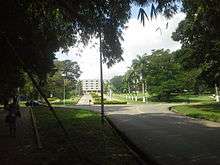
Ashanti has one public university, the Kwame Nkrumah University of Science and Technology and a Polytechnic in Ashanti capital Kumasi metropolis.[39] In addition, there are a number of private universities and university colleges spread throughout Ashanti with the majority of private universities and university colleges in Ashanti situated mainly in Ashanti capital Kumasi metropolis.[39]
Universities
- Kwame Nkrumah University of Science and Technology, Kumasi.
- Garden City University College, Kenyasi, Kumasi.
- University of Education, Kumasi Campus, Kumasi.
- National Institute Of Information Technology, Kumasi Campus NIIT.
- Kumasi Polytechnic, K-Poly.
- IPMC, Kumasi Campus.
- Akrokerri College of Education.
- St. Monica's College of Education, Mampong.
Health
Universal healthcare in Ashanti is provided by the Ashanti government and Ashanti has five hundred and thirty (530) health facilities.[40] The Ashanti monarchy government operates about 32% of all health facilities in Ashanti and the Ashanti capital Kumasi metropolis has the highest number of health facilities of Ashanti at 38% with Ashanti health facilities by ownership consisting of 170 health facilities owned by Ashanti government; 71 Ashanti health facilities owned by Ashanti mission; 281 Ashanti health facilities owned by Ashanti private institutions; and 8 Ashanti health facilities owned by Ashanti quasi government with Ashanti possessing a total of 530 health facilities.[40]
Image gallery
- Ashanti gallery
-

Kumasi at Daylight in 2003, Ashanti.
-

Neighbourhood Street in Kumasi Metropolis at Night in 2010, Ashanti.
-

Obuasi Gold Mine location, Gold Mining Community, Obuasi, Ashanti.
-
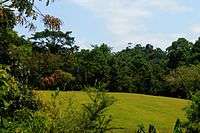
Obuasi Golf course, Obuasi, Ashanti.
-

OSC Hill, Obuasi, Ashanti.
-

Nyankomasu Waterfall, Obuasi, Ashanti.
-
Obour Nkabene at Hemang III, Kumasi, Ashanti.
-
Obour Nkabene Mountain at Hemang III, Kumasi, Ashanti.
-

Old-Growth Forest (Virgin Forest) along the Crater Lake Lake Bosumtwi.
-

Forest along the Crater Lake of Lake Bosumtwi. There is a river called Aberewa (Old Woman) which passes through this forest with a beautiful landscape and finally joins Crater Lake Lake Bosumtwi.
-

Crater Lake Lake Bosumtwi, Ashanti.
-

Shore of Crater Lake Lake Bosumtwi, Ashanti.
-

Beach of Crater Lake Lake Bosumtwi, Ashanti.
-

Okomfo Anokye's Akrafena Sword Monument, Kumasi Metropolis, Ashanti.
Famous native Ashanti citizens
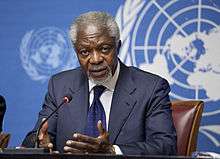
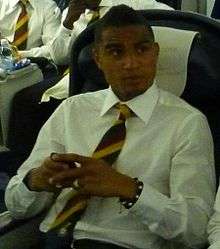
| Famous native citizens of Ashanti | ||
|---|---|---|
| # | Citizen | Settlement |
| 1 | Richmond Boakye | Agogo |
| 2 | Deborah Owusu-Bonsu | Kumasi |
| 3 | Sulley Muntari | Konongo |
| 4 | Sonia Ibrahim | Kumasi |
| 5 | Emmanuel Frimpong | Kumasi |
| 6 | Kofi Annan | Kumasi |
| 7 | John Kufuor | Kumasi |
| 8 | Isaac Vorsah | Kumasi |
| 9 | Juliet Ibrahim | Kumasi |
| 10 | Sam Jonah | Obuasi |
| 11 | Rhian Benson | Kumasi |
| 12 | Samuel Kuffour | Kumasi |
| 13 | Kofi Kingston | Kumasi |
| 14 | Tony Yeboah | Kumasi |
| 15 | Kwadwo Asamoah | Kumasi |
| 16 | Maxwell Konadu | Kumasi |
| 17 | Harrison Afful | Kumasi |
| 18 | Quincy Owusu-Abeyie | Kumasi |
| 19 | Cynthia Addai-Robinson | Kumasi |
| 20 | Kevin-Prince Boateng | Kumasi |
| 21 | Kwadwo Safo | Kumasi |
| 22 | John Mensah | Obuasi |
| 23 | Asamoah Gyan | Kumasi |
| 24 | Kwesi Appiah | Kumasi |
See also
| Wikimedia Commons has media related to Ashanti. |
References
- ↑ "Ashanti Region". Retrieved 2010-10-13.
- 1 2 3 Felix Engelhardt. "Creating an Environmental Geographic Information System for the City of Kumasi" (PDF). diva-portal.org (PDF). p. 5. Retrieved 7 August 2015.
- 1 2 3 4 "United Asante States Under Nana Osei Tutu I". asantekingdom.org.
- 1 2 3 4 5 6 7 8 "History Of The Asante Confederay » Restoration Of The Asante Confederacy". asantekingdom.org.
- 1 2 3 4 5 6 7 8 9 "Ashanti Academic Showcase". nd.digication.com.
- 1 2 3 4 "Seventy Five Years After The Restoration of Asanteman". asantekingdom.org.
- 1 2 "1956: Gold Coast to get independence". BBC.
- 1 2 3 4 5 6 7 8 9 10 11 "GHANGOLD Case". Retrieved 7 August 2015.
- 1 2 "World's top 10 gold deposits". 7 August 2013. Retrieved 7 August 2015.
- 1 2 3 4 5 6 7 8 9 10 11 12 "Meet-the-Press: Ashanti Region". Retrieved 7 August 2015.
- 1 2 3 Sheard, K. M. "Ashanti Warlike Meaning (Llewellyn's Complete Book of Names for Pagans, Wiccans, Witches, Druids)".
- 1 2 3 "The Exile of Prempeh in the Seychelles". Kreol International Magazine. 2012. Retrieved 7 August 2015.
- 1 2 3 "Asantehene visits Seychelles". Modern. 5 July 2007. Retrieved 7 August 2015.
- 1 2 3 4 5 6 7 8 9 10 11 12 13 14 "Kings Of Asante". asantekingdom.org. Retrieved 7 August 2015.
- ↑ "The Asantehene » Personality Profile". Retrieved 7 August 2015.
- 1 2 3 4 5 6 7 8 9 10 11 12 13 "Kumasi Traditional Council". Retrieved 7 August 2015.
- 1 2 3 4 "Ashanti » Ashanti Twi". ofm-tv.com.
- 1 2 3 4 "Ashanti » Ashanti Twi (Less Commonly Taught Languages)". University of Michigan College of Literature, Science, and the Arts. University of Michigan.
- 1 2 3 "Ashanti Region Executive Summary". Retrieved 7 August 2015.
- 1 2 Kumasi (5 August 2015). "NPP Has Track Record… of protecting the public purse, says Nana Addo". The Chronicle. Archived from the original on 7 October 2012.
- 1 2 3 4 5 6 "Kumasi Metropolis Tourism Attractions". Kumasi Metropolitan Assembly. Retrieved 6 August 2015.
- 1 2 3 4 5 6 7 8 9 10 "Kumasi Metropolis Physical Characteristics". Kumasi Metropolitan Assembly. Retrieved 7 August 2015.
- ↑ "Profitability Analysis of all-male Tilapia Farming in Sekyere South and Bosomtwe Districts of Ashanti Region". researchgate.net (PDF). Retrieved 7 August 2015.
- ↑ Ashanti Region
- ↑ "Kumasi Good Governance". Retrieved 7 August 2015.
- ↑ Ashanti Region. Geohive.com.
- 1 2 3 "The Historic And Present Importance Of Asante- Its Culture And Economy". asantekingdom.org.
- 1 2 3 4 5 6 7 8 9 10 "Kumasi Metropolis Economy". Kumasi Metropolitan Assembly. Retrieved 7 August 2015.
- ↑ "Updates on Kwadwo Safo's Works". kumatoo.com. 3 January 2014. Retrieved 7 August 2015.
- ↑ "Ashanti Region CEPS targets 172 billion cedis in revenue this year". Retrieved 7 August 2015.
- ↑ Ashanti Region
- ↑ Ashanti Region
- ↑ "The Adae Kese Festival". Retrieved 7 August 2015.
- ↑ "Kumasi Sports Stadium Ready". TheStatesManOnline.com..
- ↑ "Africa's club of the Century". IFFHS official website. Retrieved 2015-08-05.
- ↑ "Obuasi Sporting Club". Retrieved 2015-08-07.
- 1 2 3 "Ashanti (Twi) – Ashanti language". amesall.rutgers.edu.
- 1 2 3 Language The Alternation Strategies in Multilingual Settings. Peter Lang. 2006. p. 100. ISBN 0-82048-369-9.
- 1 2 3 4 "Kumasi Metropolis Educational Sector". Kumasi Metropolitan Assembly. Retrieved 7 August 2015.
- 1 2 "Ashanti Region - Regional Health Directorate". Retrieved 7 August 2015.
| |||||||||||||||||||||||||||||||||||||||||||
| ||||||||||||||||||||||||||
| ||||||||||||||
| ||||||||||||||
| |||||||||||||||||||||||||||||||||||||||||||||||||||||||||||||||||||||||||||||||||||||||||||||||||||||||||||||||||||||||||||||||||||||||||||||||||||||||||


_Ashanti_autonomous_region_map.png)
